List Building: How to Build an Email List
Written by Brian Dean

Today I’m going to show you how to build your email list (FAST).
In fact:
The strategies in this post helped me grow my list from scratch… to 172,126 subscribers:

And today I’m going to show you the exact list building strategies that I used to get these results.
Click a section below to be taken right to one of the strategies.
- 1. Use Content Upgrade Popups
- 2. Hack Qualaroo To Build Your Email List Fast
- 3. Optimize This Often-Ignored Page and Increase Your List By Up To 25%
- 4. Limit The Number of Options
- 5. Use This Simple Trick to Solve The “Social Proof Paradox”
- 6. Use BuiltWith.com To Steal Your Competitor’s Best Conversion Tools
- 7. Use The LPF Technique to Turn More Blog Traffic Into Subscribers
- 8. Turn Your LinkedIn Group Into a List Building Fire Hose
- 9. Use These 8 Words to Dramatically Increase The Value Of Your Giveaway
- 10. Giveaway a Bonus For YouTube Videos
- 11. Use “Readers” or “Visitors” to Generate Social Proof
- 12. Pitch Your Email Newsletter to Twitter Followers
- 13. Surprise New Subscribers With a Free Bonus
- 14. Use a Blog Post Teaser
- 15. Use Weird Call to Actions on Buttons
- 16. Turn Blog Comments Into Email Subscribers
- 17. About Page=Squeeze Page
1. Use Content Upgrade Popups
Look:
Love ’em or hate ’em, popups work.
For example, a while back I decided to try using a popup.
Here’s what the popup looks like:

That popup form may look simple, but it converts at an impressive 3.42%.
And it took my subscriber numbers from 35/day to 75/day.
In fact, that simple-looking popup added over 3600 new subscribers to my email list in 3 months.

Although I’m happy with those results, I’m excited to tell you that I’ve discovered a way to make popups even more powerful.
How?
By adding The Content Upgrade to the mix.
Never heard of the The Content Upgrade? No worries.
This post will show you how I used The Content Upgrade to increase conversions by 785%.
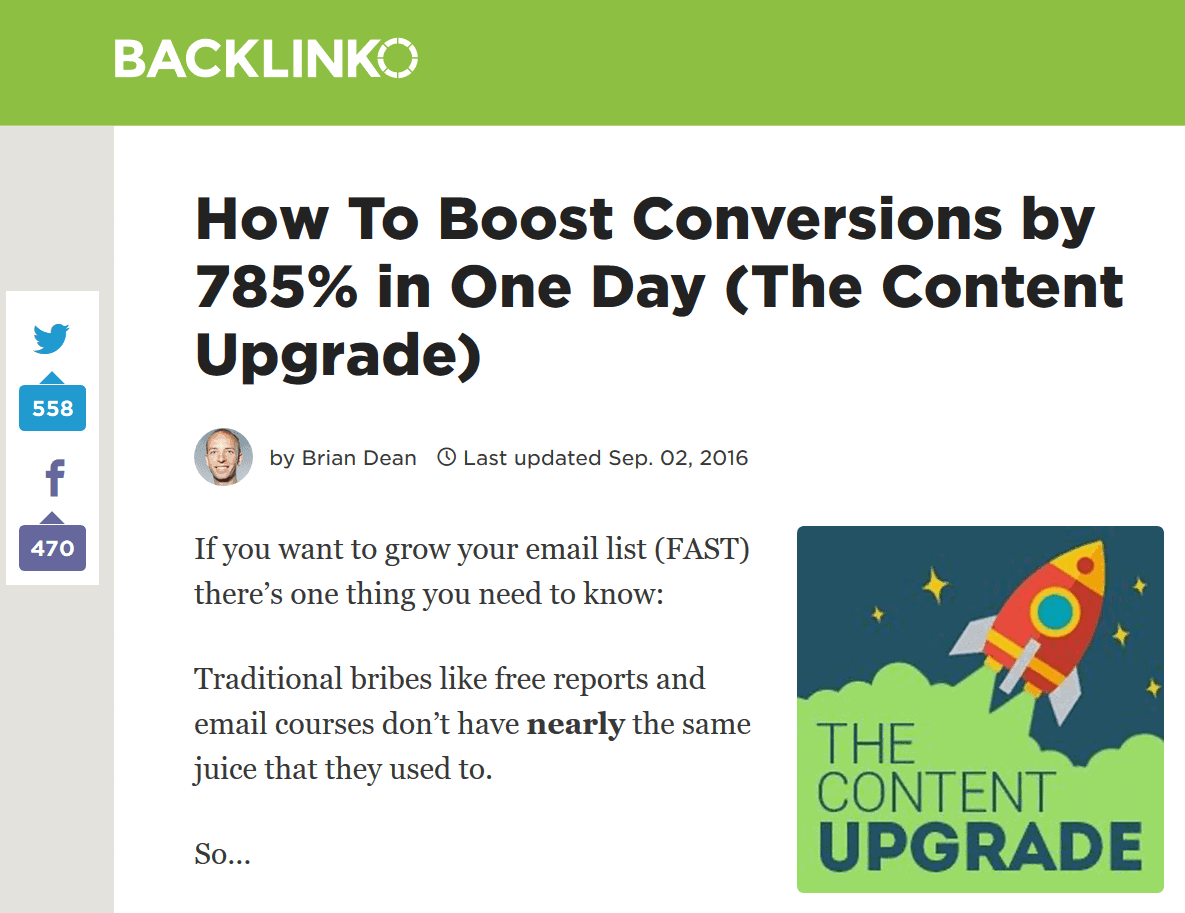
(If you want to learn how to build an email list, The Content Upgrade should be high on your list of things to master).
As you saw in that post, page-specific offers convert WAY better than something generic (like “free updates”).
For example:
In my Google Ranking Factors post, I give away a checklist that makes the information from that post much more actionable:

And then it hit me:
Why would I offer someone something VERY specific with The Content Upgrade…
…and then turn around and make a generic offer in my popup?
That doesn’t make any sense.
So I decided to create a page-specific popup that pitched my Google Ranking Factors checklist.

The result?
A 65% increase in conversions vs. the generic offer.
Imagine how many A/B tests you’d have to run to increase conversions by 65% (hint: a lot).
Why would waste time testing button colors when you can do something like this that’s almost guaranteed to generate results right away?
Speaking of a strategy that gets results right away…
Tweet this List Building technique
2. Hack Qualaroo To Build Your Email List Fast
Here’s one of the most creative list building strategies I’ve ever seen:
You may already be familiar with Qualaroo, a survey tool that asks live questions to visitors on your website.
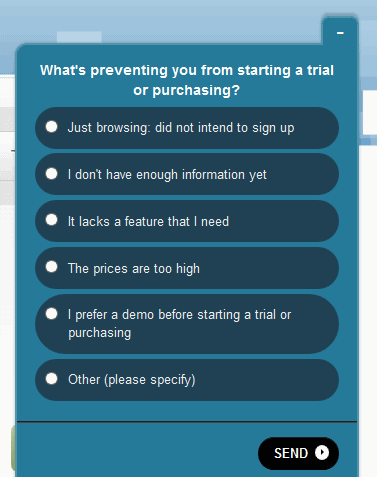
While Qualaroo is great at surveying your site’s visitors, you may not know that you can ALSO hack this tool to build your email list.
In fact, The University of Alberta recently used this same hack to boost subscribers by more than 500%.
Here’s how they did it…and how you can do the same thing on your site.
The University was looking to increase conversions on their email updates page, which you can see here:
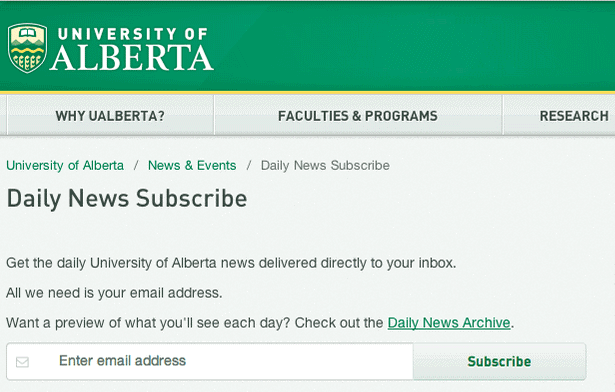
Instead of using Qualaroo to poll their visitors, they had the tool encourage people to sign up to their email newsletter:

In fact, they set it up so you can literally subscribe directly through the Qualaroo form!

Did it work?
In a word: YES!
This Qualaroo form pushed their signups from a sad 1-2/day…
…to a respectable 12-15/day without making any other changes to that page.
3. Optimize This Often-Ignored Page and Increase Your List By Up To 25%
I’ve got good news and bad news…
First, the bad news:
If you make people double opt-in to join your list, up to 25% of your subscribers may be falling through the cracks.
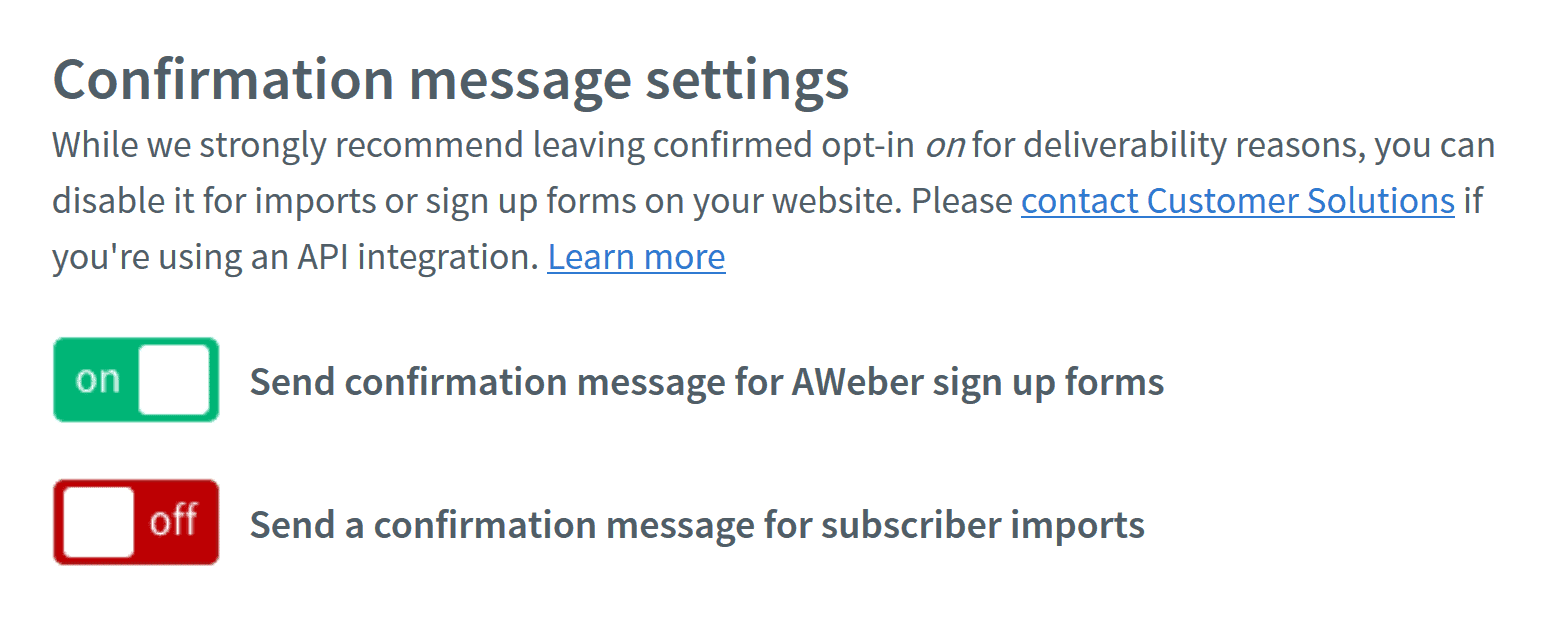
Why?
Sometimes your “Confirm your subscription” email gets caught in their spam filter.
Sometimes they change their mind.
Sometimes the dog poops on the rug and they forget to confirm.
Now for some good news:
You can significantly boost your subscriber numbers by getting more of your opt-ins to actually confirm their email.
How can you do that?
Optimize your confirmation page.
I’m happy to say that my confirmation page loses VERY few people. Here’s what it looks like:
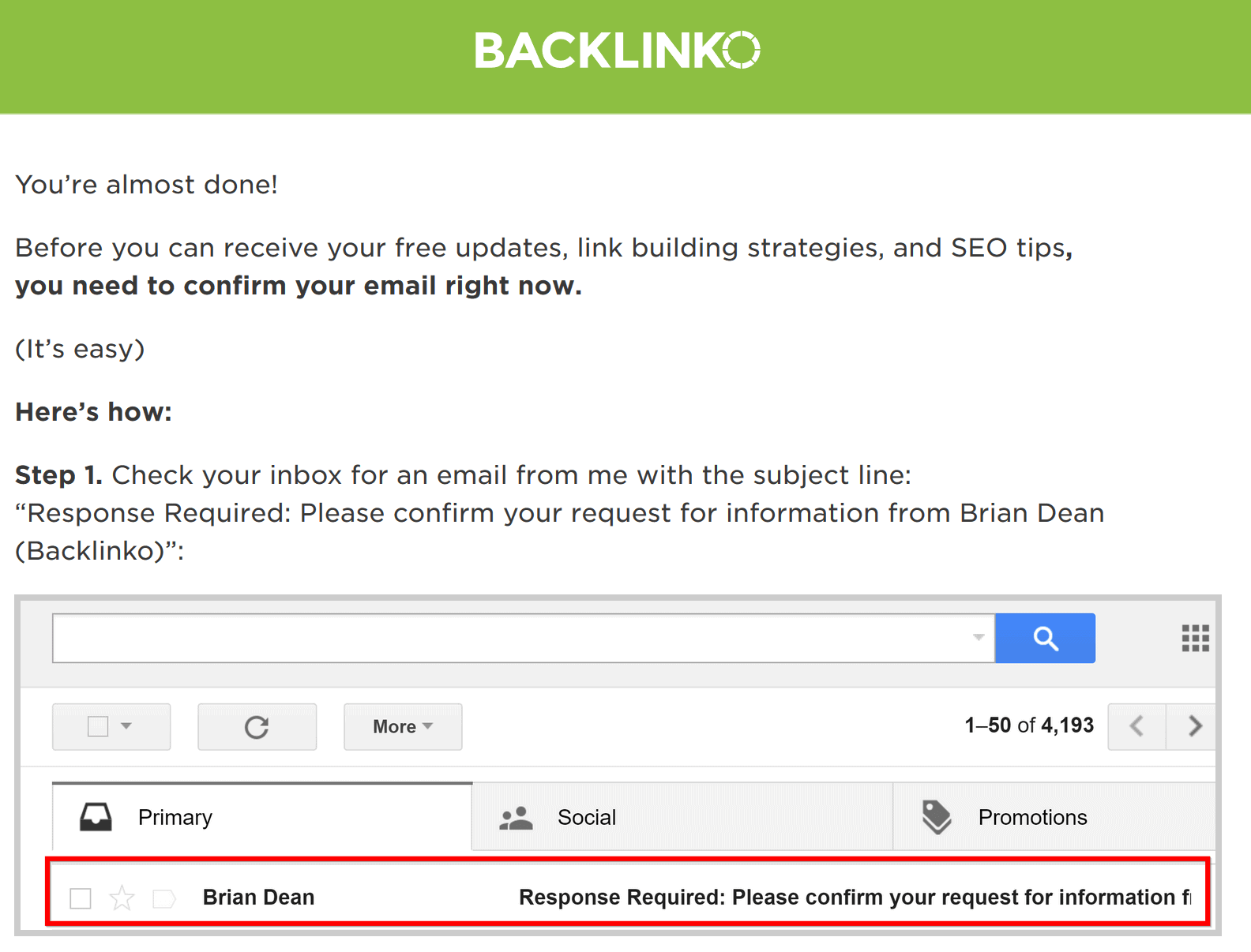
Let’s break down the 3 reasons this page works better than most confirmation pages.
First, I re-iterate the benefits of subscribing.
I quickly remind you why it’s worth going through the trouble of confirming your email.
The second line on the page is:

Most people say something like, “in order to subscribe to our newsletter, you need to confirm your email”.
What’s more likely to motivate you to double opt-in?
Free updates, strategies and tips…or subscribing to a newsletter? Thought so.
Second, I include a strong call to action that asks them to confirm right away.

This is HUGE. If someone doesn’t confirm right away they’re MUCH less likely to ever do it.
In fact, Ramit Sethi actually has a countdown timer on his confirmation page. Awesome.
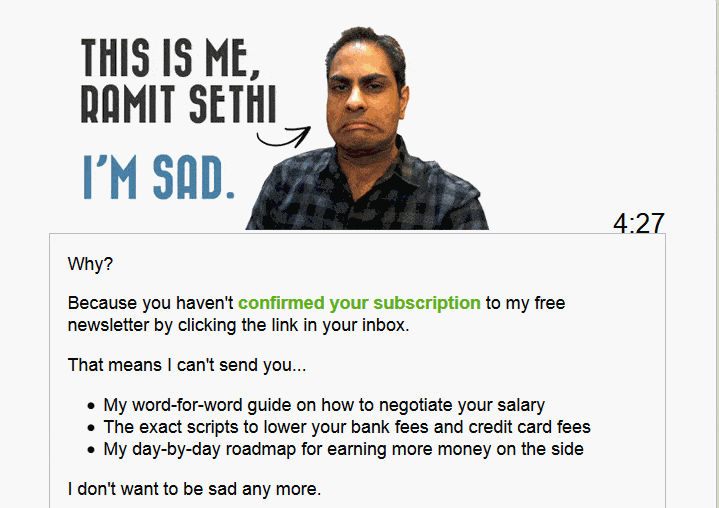
Third, I visually walk you through the exact steps you need to take in order to confirm your email.

Even if you’ve already signed up to a million email lists, the visual cues reinforces what you’re supposed to do.
(It also shows that you’re a helpful person)
Tweet this List Building technique
4. Limit The Number of Options
Which sounds better to you?
Making millions from the stock market…
…or being lazy and eating Cheetos on your couch?
I know, it’s a silly question.
I only ask because those are the two options Timothy Sykes offers on his exit intent popup. You may have seen other “Powered By Bounce Exchange” popups around the web.
You may have seen other “Powered By Bounce Exchange” popups around the web.
Although each Bounce Exchange popup has a unique design, they have one thing in common:
They make you feel like an idiot for not opting in.
For example, here’s a Bounce Exchange popup from MensHealth.com (note the “No thanks, I’m not looking to lose weight” option):

You might be asking yourself:
“Why would they give someone a stupid option like that?”
The simple answer to that question: scientific research shows that two options convert MUCH better than one option.
In a recent study published in the Journal of Consumer Research, Professor Daniel Mochon of Tulane University uncovered a phenomenon known as “Single Option Aversion“:
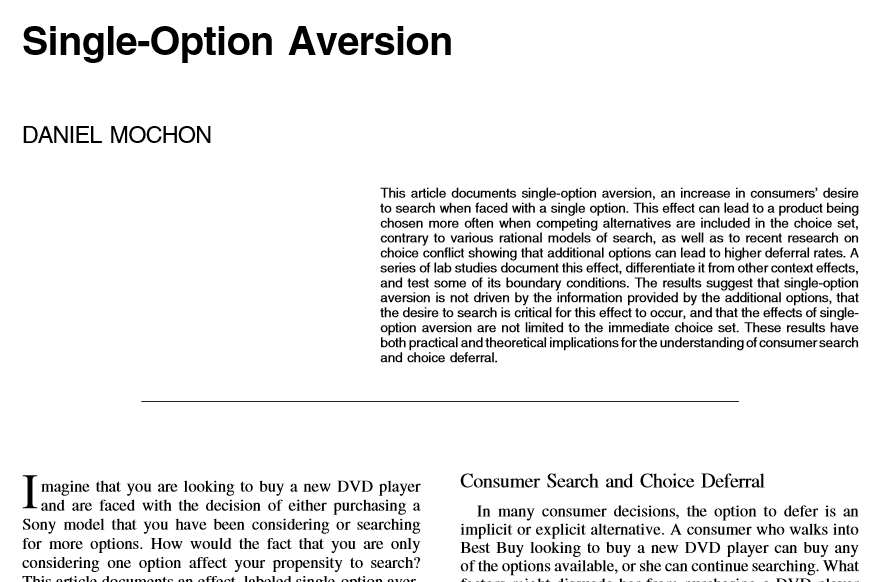
Here’s what went down:
Mochon asked 3 groups of research subjects to imagine that they were in the market for a new DVD player.
Mochon gave one group of people information about JUST a Sony DVD player. Here’s what that information looked like:
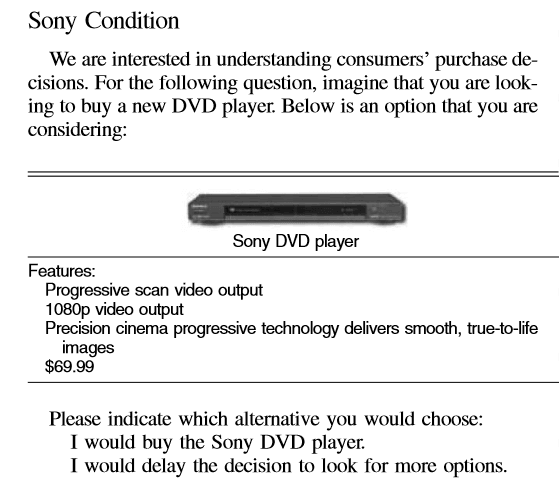
He gave a second group information only about a Philips DVD player (that looked similar to the above example).
And a third group received information on both the Sony AND Philips DVD player:

What happened?
When presented with JUST the Sony or Philips DVD player information, approximately 10% of subjects said they’d be ready to buy right away.
Here’s the interesting part:
33% of subjects presented with both Philip and Sony DVD player options said that were ready to make a decision right then and there.
That’s 3x more than people that only saw one option.

Bottom line:
Including a second option (even a silly one) will convert more people into email subscribers.
Tweet this List Building technique
5. Use This Simple Trick to Solve The “Social Proof Paradox”
There’s one piece of conversion advice that drives me nuts.
“If you want more people to subscribe to your email list, use social proof. Show people how many subscribers you already have.”
That sounds great in theory…
But what if you only have 17 people on your email list? How is that going to boost social proof?
It’s what I call the “Social Proof Paradox”.
You need social proof to get subscribers. But you need subscribers to get social proof.
It’s a classic chicken or the egg problem.
So what’s the solution?
Testimonials.
Here’s an example from one of my newsletter sign up pages:

Here’s another example:
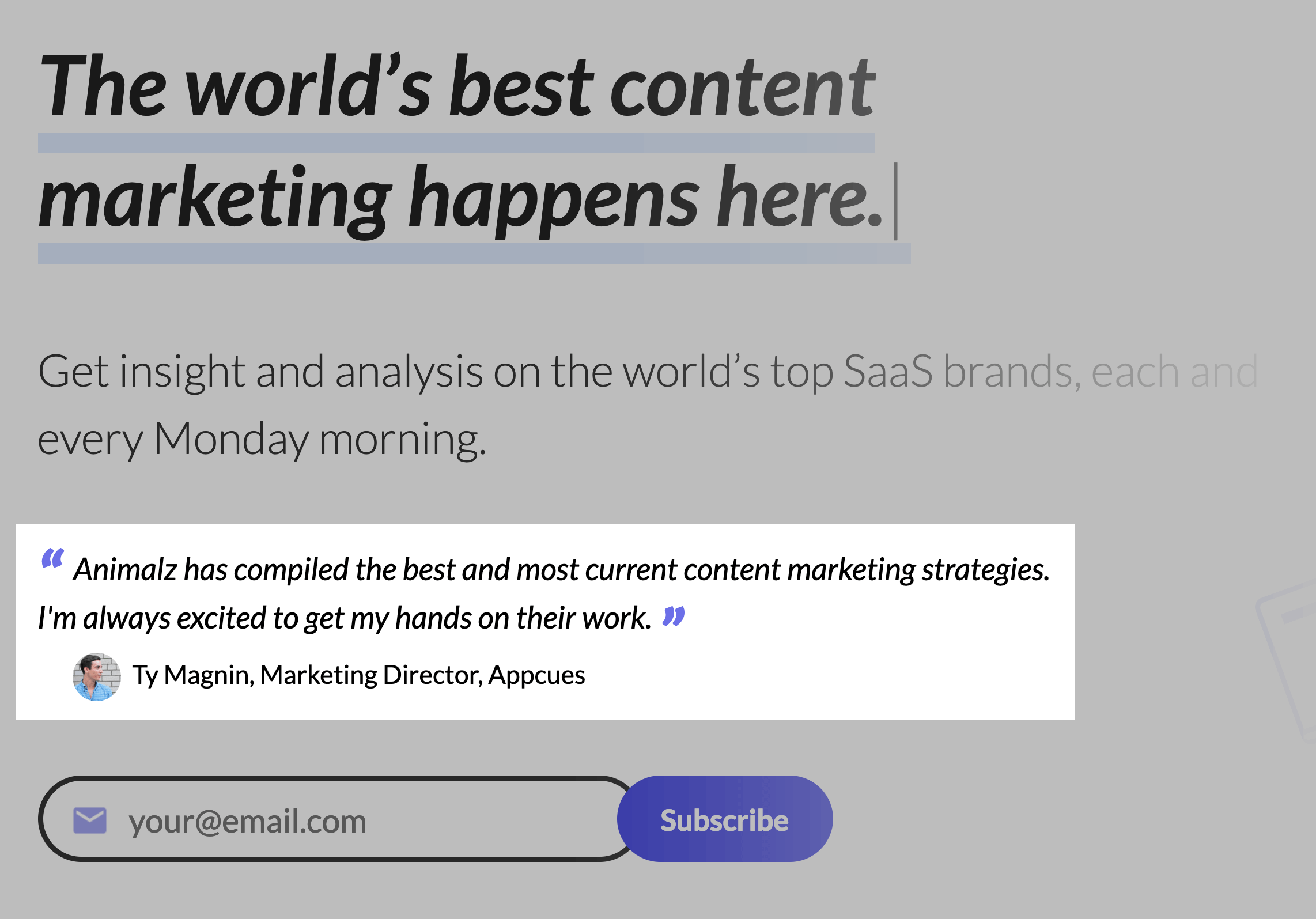
See that?
You don’t need a 30,000-person email list to demonstrate social proof. A single testimonial is enough.
(In fact, I’ve found that a single glowing testimonial is often more powerful than “I already have 89,541 subscribers”)
Tweet this List Building technique
6. Use BuiltWith.com To Steal Your Competitor’s Best Conversion Tools
What’s the fastest way to find the best conversion tools for YOUR business?
That’s easy:
Use the same tools that your competitors use everyday.
But how?
Well you could try to learn how to build an email list completely on your own…
…or you could look at a competitor site’s source code and try to piece things together yourself.

(Good luck with that)
Or you can use this little-known tool called Built With that shows you the EXACT tools your competition uses to build their email list.
How does it work?
First, enter the homepage URL of one of your competitors into the tool:

The tool will show you competitive information, like links and traffic sources:
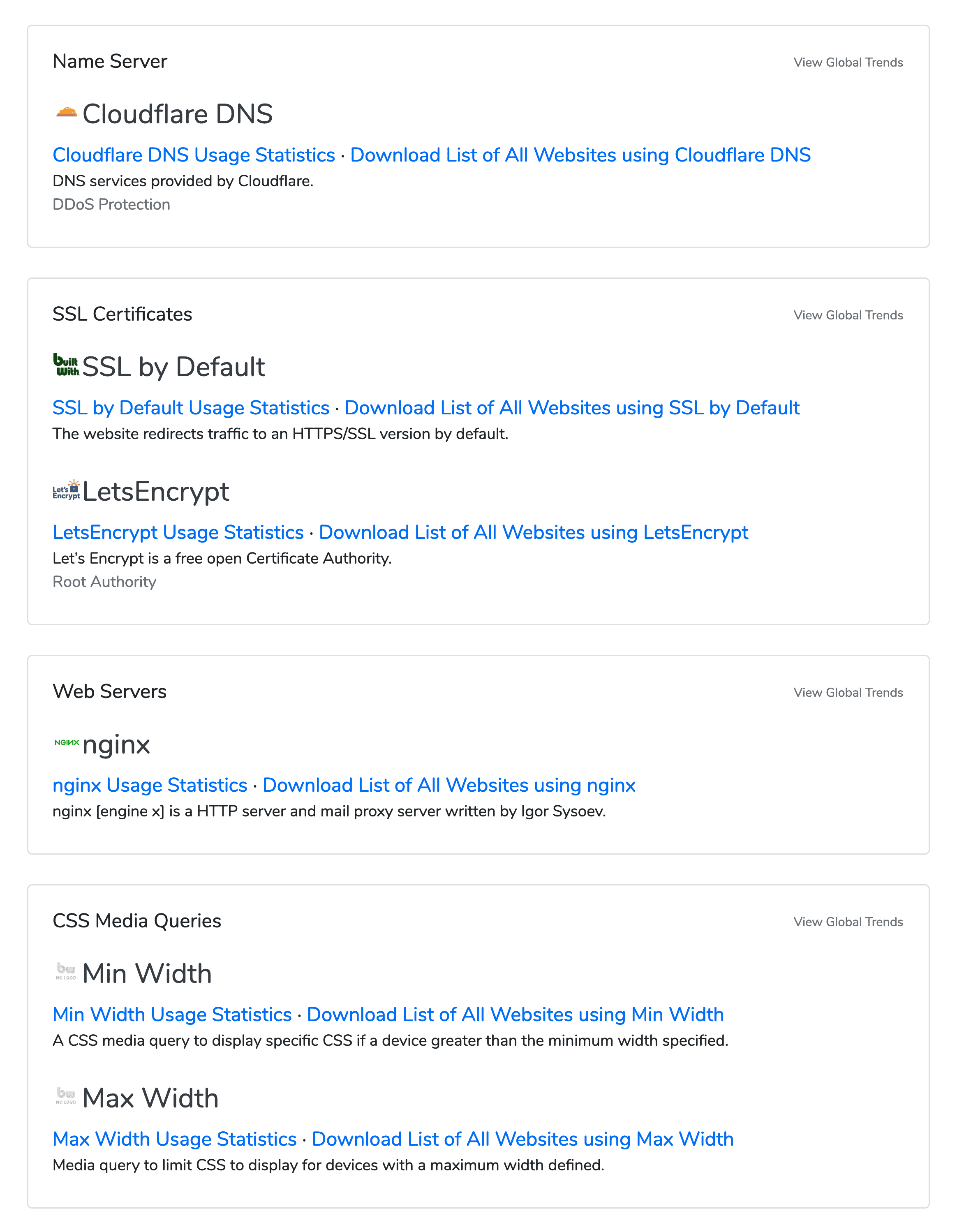
But you want to focus on the “Analytics and Tracking” section:
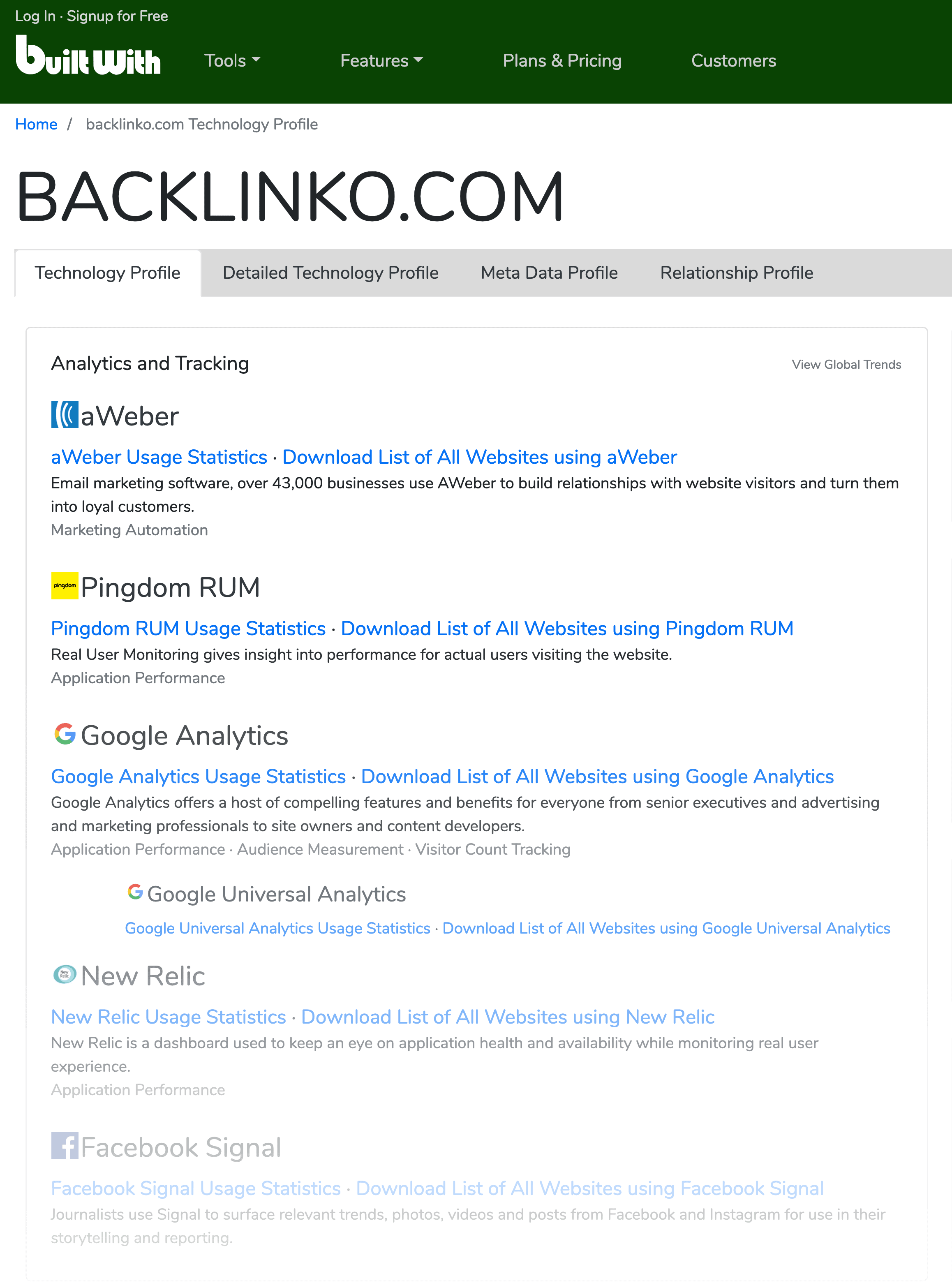
That box will show you every tool that your competitor’s site uses…including tools that they use for split testing, email marketing and more.
Pretty awesome, right?
Tweet this List Building technique
7. Use The LPF Technique to Turn More Blog Traffic Into Subscribers
Quick question:
What’s the #1 page you want someone to visit to when they come to your blog?
If your answer is, “one of my best blog posts”, you’re missing out on HUNDREDS of potential subscribers.
So…what’s the right answer?
You want your visitors to go to pages designed to collect emails. In other words, landing pages.
As you may have read in my recent post, How to Create a Page That Converts at 21.7% (Step-By-Step Case Study), I recently created a Social Squeeze Page on my blog that converts at (you guessed it) 21.7%.
Here’s what the page looks like:
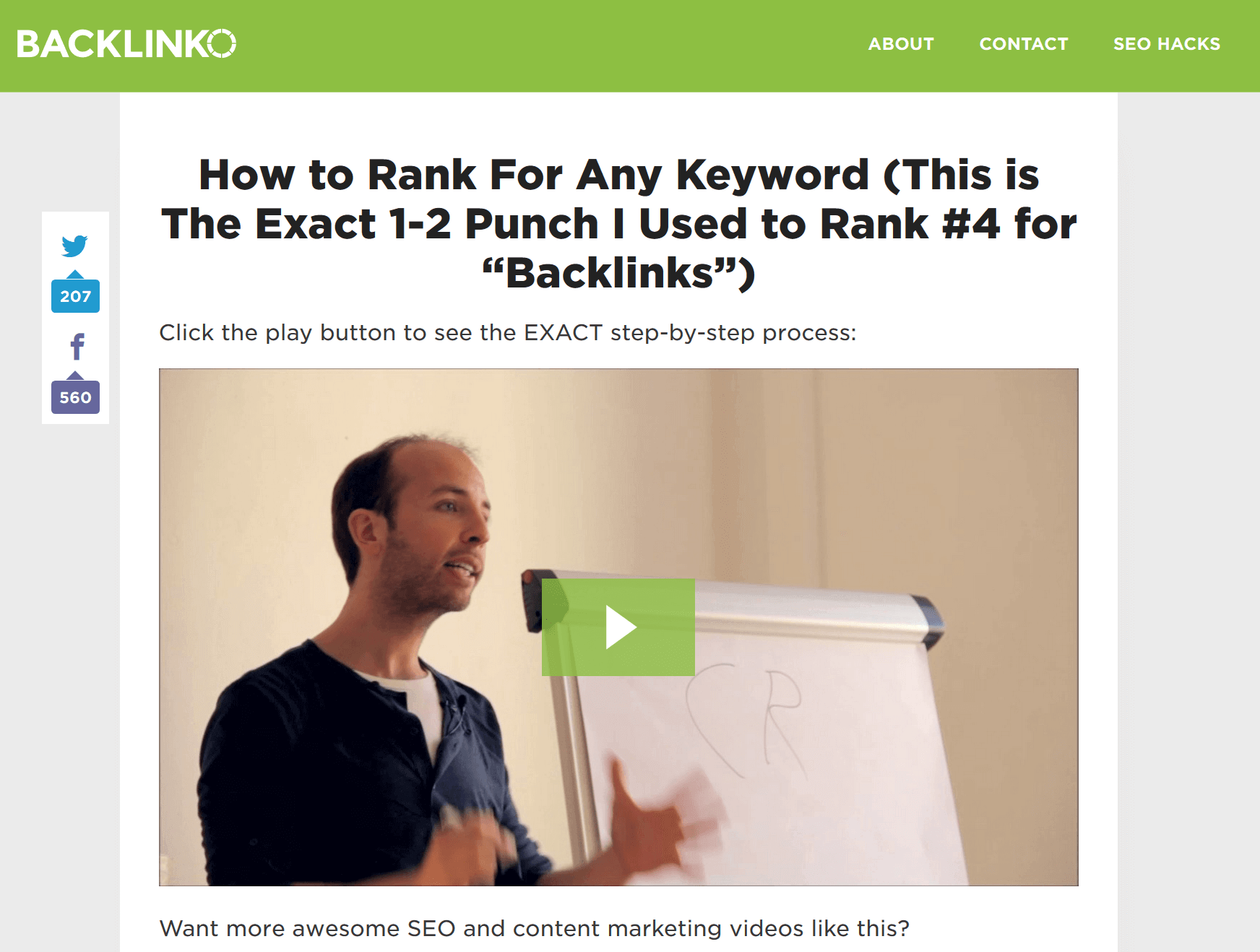
Problem is:
How do you get your site’s visitors to land on your best-converting landing pages?
It’s actually pretty simple: strategically funnel your blog’s traffic using the Landing Page Funnel (LPF) Technique.
The 2-step LPF technique is very simple.
- First, you identify landing pages that convert well on your site.
- Second, you design your site to funnel people to those high-converting pages.
Here’s an example of how I use the LPF technique at Backlinko:
As I mentioned, my Social Squeeze Page is the best-converting page on Backlinko. So that’s one high-converting page.
But I also have a newsletter sign up page that converts at around 10%.

So for me, my Social Squeeze Page and my Newsletter page are my top 2 best-performing pages.
Step #1=done.
Next, I added links around my site that point to those two pages.
Like in my site’s top navigation:

And a text-based link under the “Popular Articles” section of my sidebar:

Michael Hyatt uses the LPF Technique in his blog…
Michael deftly includes a “Subscribe” link at of his blog’s navigation.
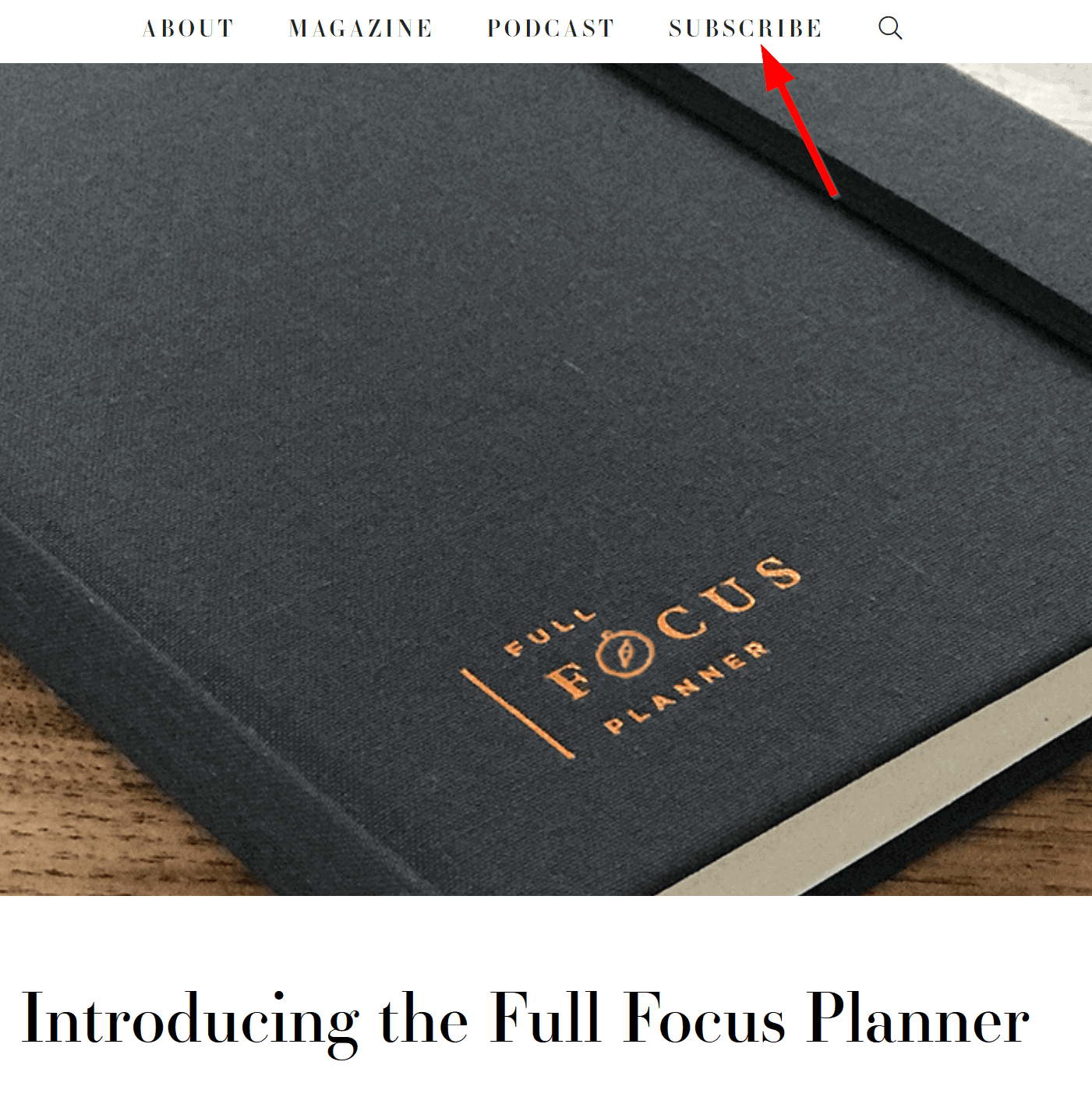
It just so happens that this “Subscribe” link takes people to an attractive squeeze page that no doubt converts extremely well:

Very smart.
Tweet this List Building technique
8. Turn Your LinkedIn Group Into a List Building Fire Hose
A few weeks ago I stumbled on a brilliant list building strategy using the untapped power of LinkedIn.
Here’s what happened…
There’s this group on LinkedIn called the Sports Industry Network:
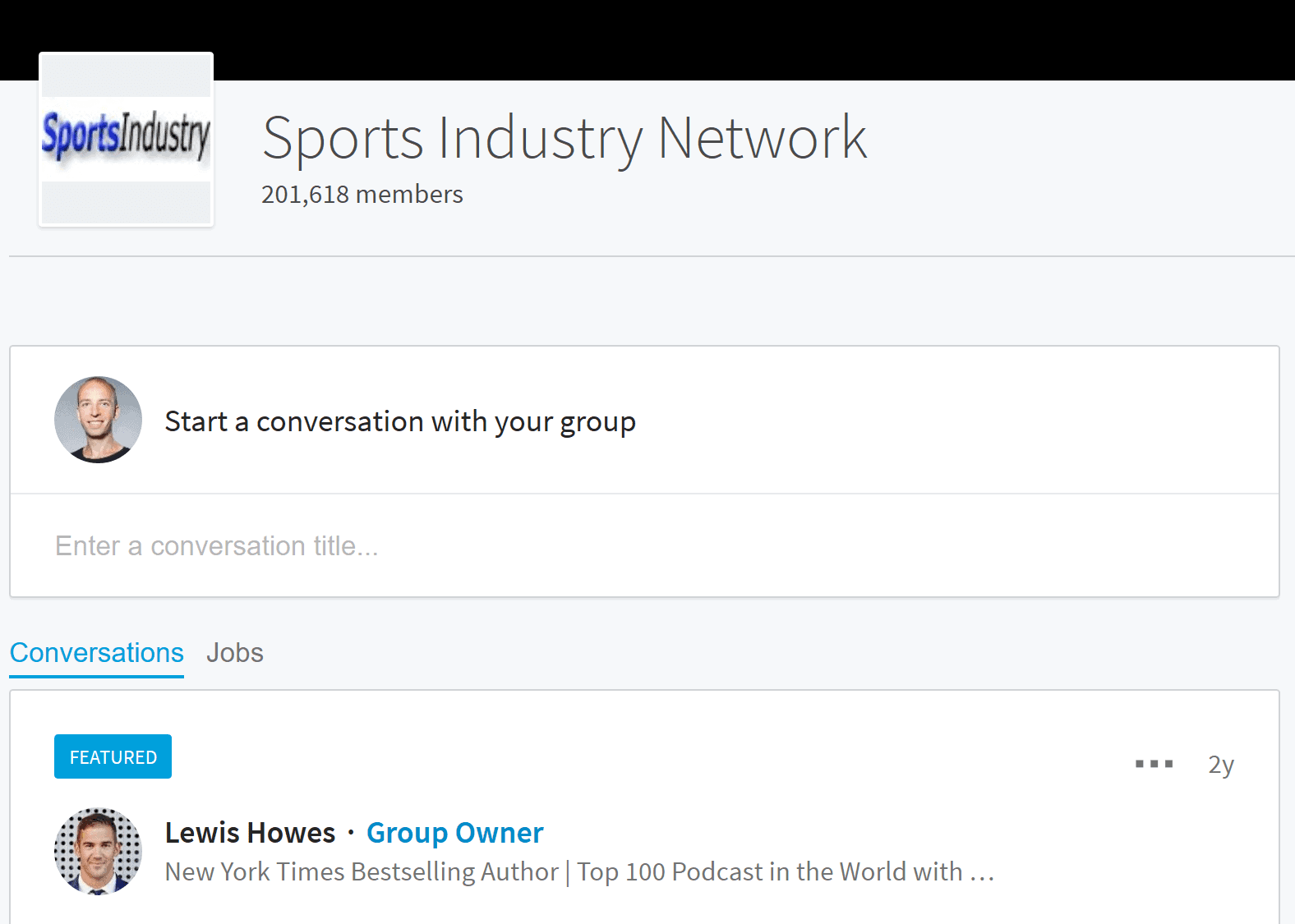
Like most LinkedIn groups, the Sports Industry Network sends you a “Welcome to the Group” email after you join.
Here’s the email that they sent to me:
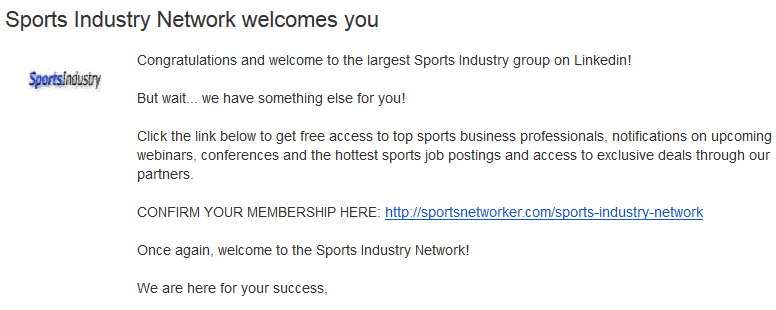
As you can see, the group asks you to “confirm your membership” to access to exclusive content.
And where does that link in the email lead to?
You guessed it:
A well-designed landing page.

Brilliant.
If you run a LinkedIn group, you can easily do the same thing by going to Manage–>Temples–>Welcome Message:
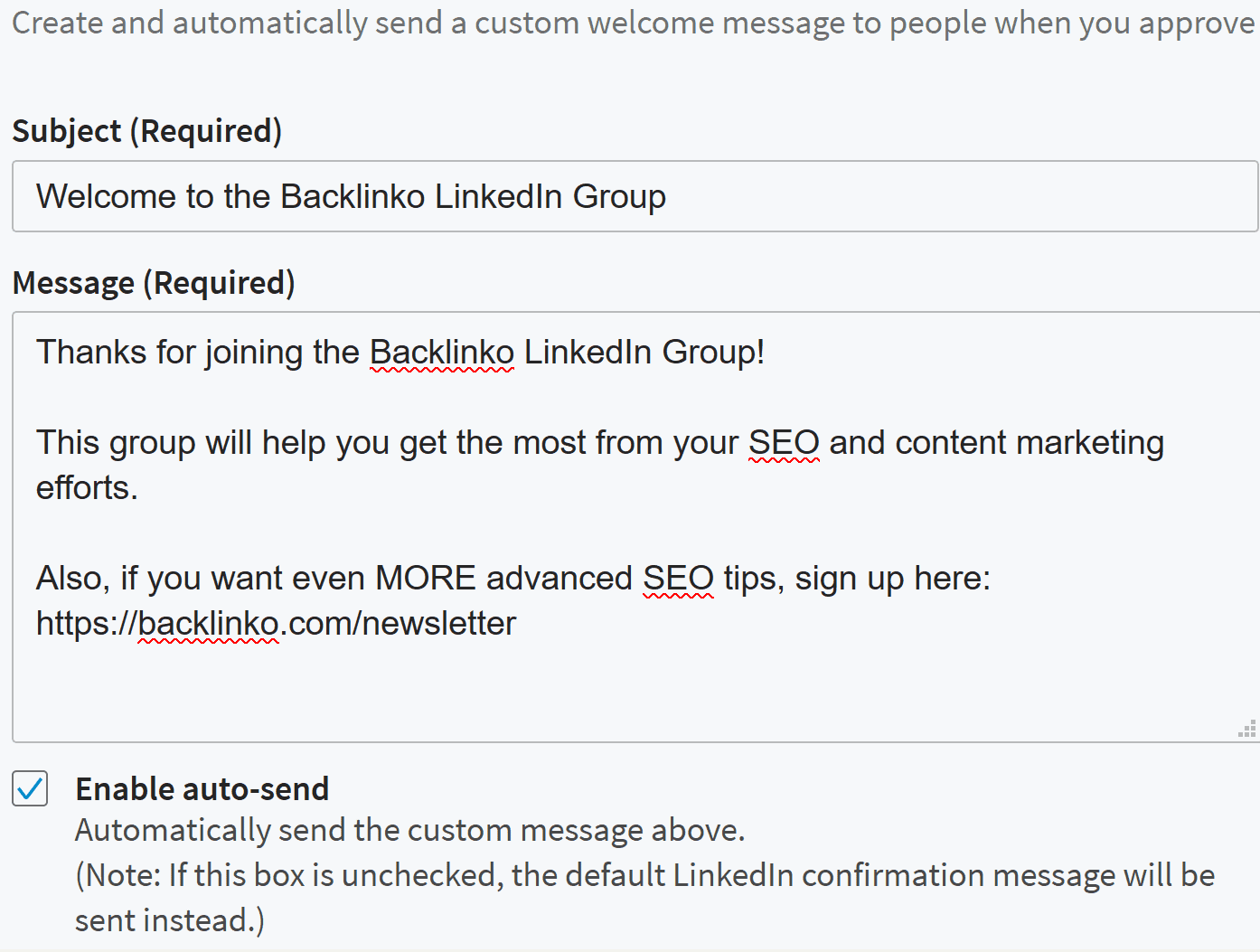
And add a link to your squeeze page in the welcome message that goes out to new members.
Tweet this List Building technique
9. Use These 8 Words to Dramatically Increase The Value Of Your Giveaway
I’m pretty sure you’re with me on this one:
“Featured Download” sounds MUCH more appealing than “Sign up for our newsletter”.
That’s probably why the HubSpot blog uses that exact pitch on their site (and has over 225,ooo subscribers to show for it).
If you read the the HubSpot blog, you may have noticed a banner that slides in from the bottom right-hand corner of the page.
Here’s an example:

And when you click the “Download Now” button, you’re taken to a landing page:
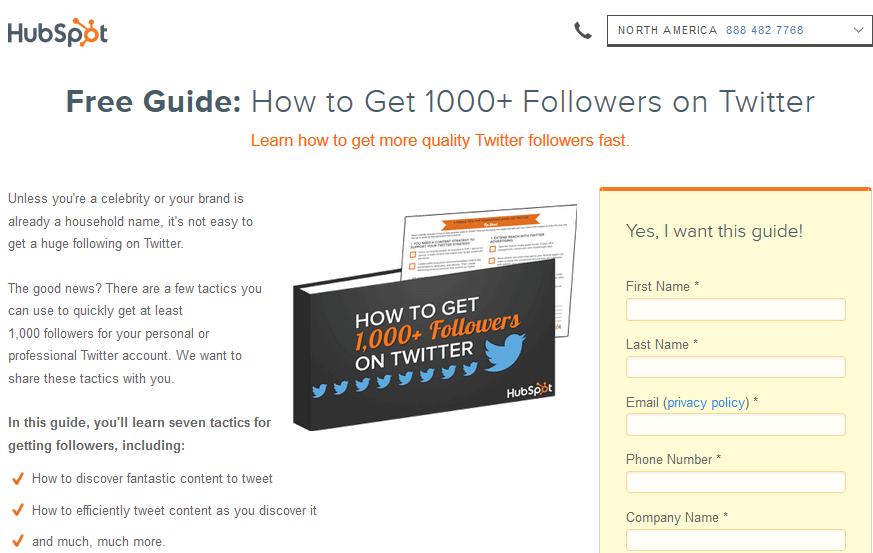
What makes this approach so effective?
The simple answer: traditional pitches like, “Sign up to my list and get a free ebook” don’t get the job done today.
But when you describe your opt-in bribe (like a free ebook) with value terms, it adds rocket fuel to your offer’s perceived value.
Direct mail marketers have used these words for decades to increase the perceived value of their offers…
…and you can do the same.
Here are value terms you can use to make your giveaway more enticing:
- “Featured”
- “Exclusive”
- “Advanced”
- “Download”
- “Secrets”
- “Access”
- “Special Offer”
- “Limited Time”
In fact, I use several value terms on my newsletter squeeze page:

Even though I don’t give anything tangible away on that page, these value terms bump up the perceived value of my newsletter.
A word of warning: you don’t want to use more than 3 of these in a single offer.
“Exclusive Access to a Featured, Limited Time Download” is a little overboard 🙂
Tweet this List Building technique
10. Giveaway a Bonus For YouTube Videos
When it comes to marketing on YouTube, there’s one thing that almost everyone can agree on:
YouTube click through rates are HORRIBLE.
In fact, some estimates put the average YouTube CTR at 0.72%.
Knowing that, how can you get your YouTube viewers to click over to your site and sign up for your email list?
The same thing you’d do on your blog: give something away!
Brandon from Sold With Video is one of the few people on YouTube applying the tried-and-true giveaway formula to YouTube.
For example, at the end of his video about getting more YouTube views, he pitches a free mini-course to help people with YouTube SEO.

And when you click on the yellow “Get Access Now” button you see above, you’re swept away to a squeeze page.
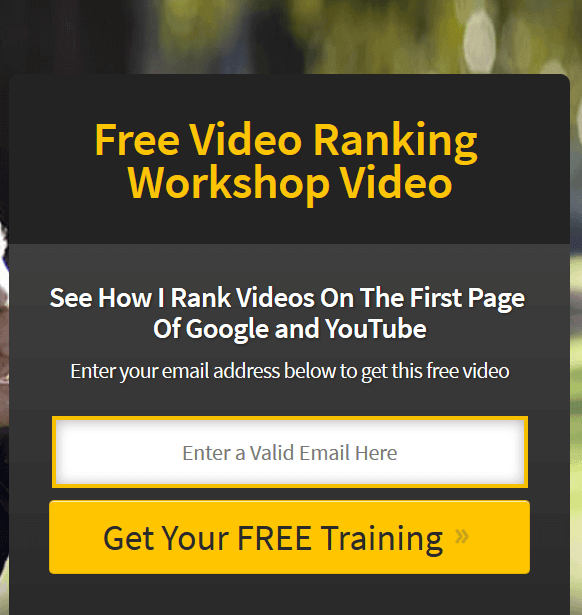
How can you do the same thing?
First, think of a giveaway that viewers of that video might be interested in.
For example, if you had a video about building bigger biceps, you could offer a free Excel spreadsheet that helps people track their workout.
Next, add a card to your video that stands out. This button should link to your opt-in page:

And you’re set.
Tweet this List Building technique
11. Use “Readers” or “Visitors” to Generate Social Proof
I already told you about the “Social Proof Paradox” and the dead-simple technique you can use to solve it.
Skipped that one? Go back and check it out. It’s #6 on this list.
What I haven’t told you is that there’s another easy way to make your blog look like a thriving community…
…even if you only have 134 email subscribers.
How?
Feature your blog’s monthly visitors.
If you’re like most people, your total monthly visitor count is larger than your Facebook fans, email subscribers or any other traditional form of social proof.
That’s why you want to feature THAT number on your blog.
Here’s an example that I used to have on my blog:
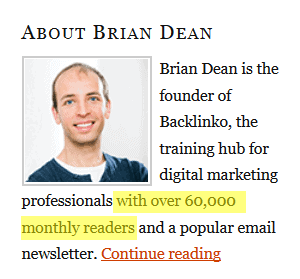
The only time I wouldn’t use this technique is if you’re getting less than 5,000 monthly visitors.
In that case, you want to focus on reader and subscriber testimonials until your traffic climbs to 5000+ monthly uniques.
Tweet this List Building technique
12. Pitch Your Email Newsletter to Twitter Followers
You may think that most of your Twitter followers are also on your email list…
…but you’d be wrong.
And if you don’t pitch your email list to your Twitter followers, you’re missing out on some of the easiest subscribers you’ll ever get.
After all, your Twitter followers are people that already like you. That makes your email list an easy sell.
For example:
A while back I tweeted this out:
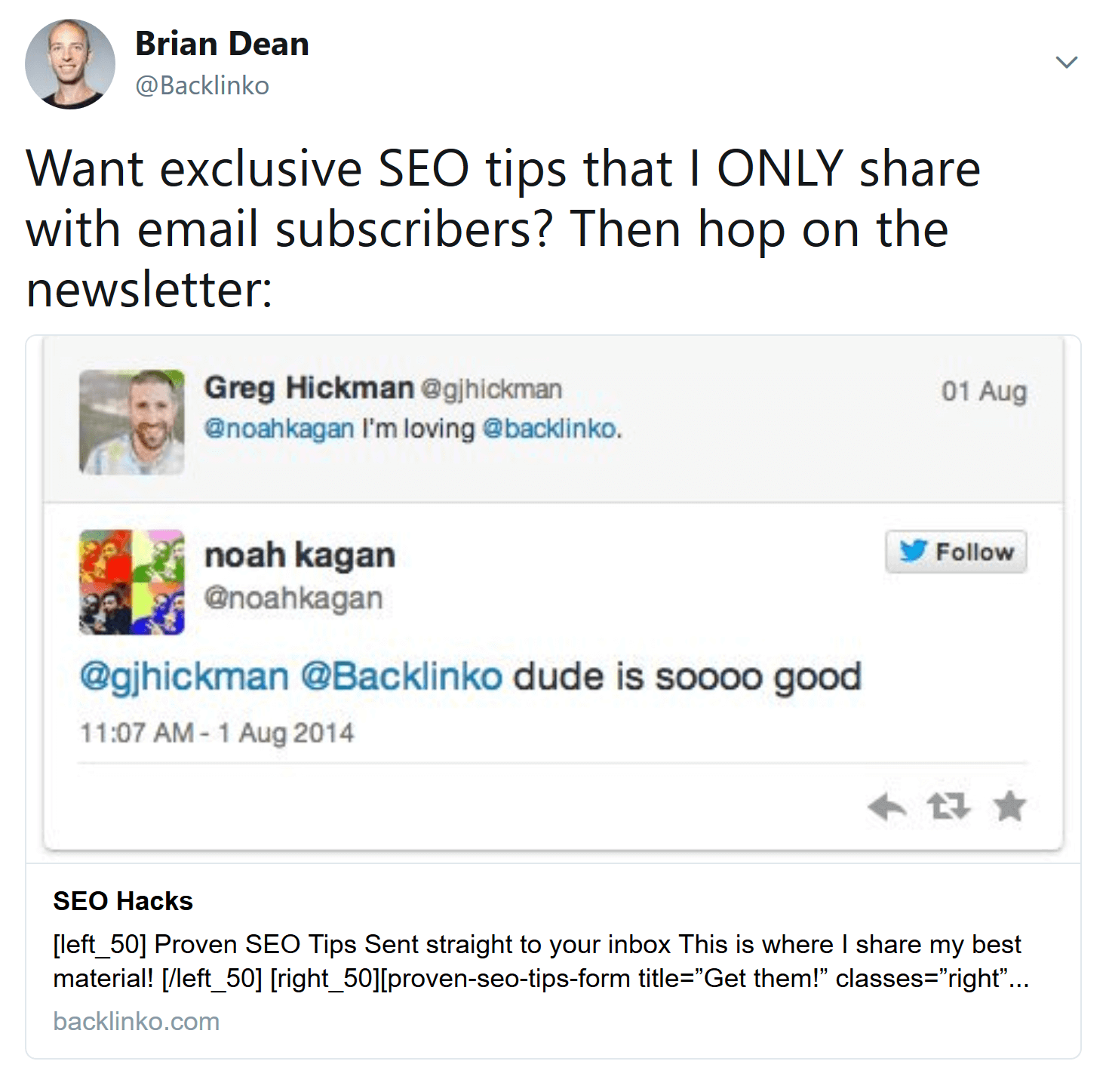
And that tweet very quickly added a handful of subscribers that I otherwise wouldn’t have had.
Because it’s so easy and effective, I plan on pitching my email list on Twitter, Facebook and LinedIn on a regular basis from now on.
Tweet this List Building technique
13. Surprise New Subscribers With a Free Bonus
Have you ever heard this classic business quote?
“It’s 5x cheaper to keep a customer than to gain a brand new one.”
Well it’s the same story with your email list:
It’s MUCH easier to prevent someone from clicking “unsubscribe” than it is to get a new person to fork over their email address.
But how?
That’s easy: give your subscribers an unannounced bonus for signing up.
For example, I used to give new subscribers a free unannounced ebook, “How to Get 25,000 Visitors Per Month” immediately after they confirmed their email:
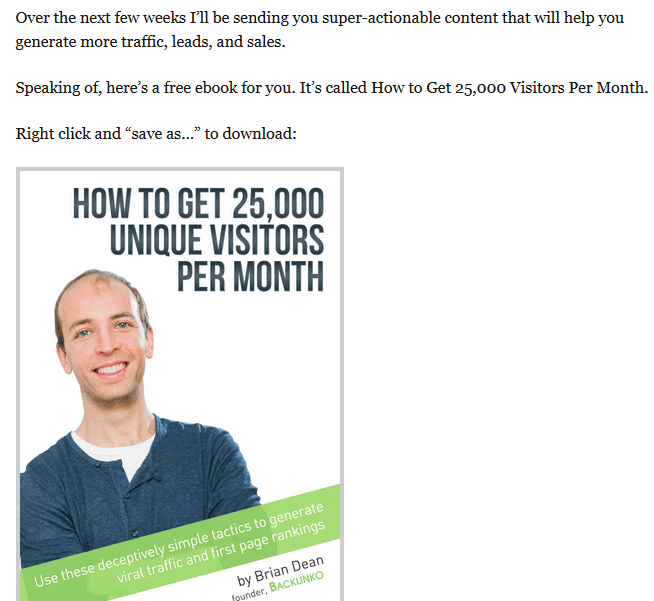
Make no mistake:
This ebook was 25 pages of pure awesomeness.
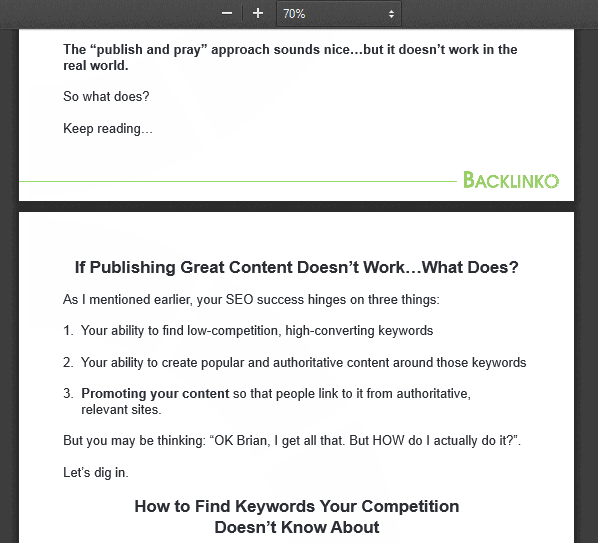
The content in that ebook was as good — if not better — than anything I’ve published on the blog.
And I’ve received emails from (literally) hundreds of subscribers telling me that they’ve learned a lot from it:



Not only do these emails give me a warm fuzzy feeling inside, but they let me know that my ebook is turning casual fans into lifetime subscribers.
(Unfortunately, I let the ebook slip out of date and removed it from the email confirmation page. I may add it again soon)
You can easily set this up yourself:
Just create a high-quality report, ebook or checklist.
Then, give your resource to subscribers right after they sign up.
And — KAPOW! — you’ll make an awesome first impression with everyone that signs up for your list.
Tweet this List Building technique
14. Use a Blog Post Teaser
You probably already know that “fear of loss” is a HUGE motivator.
When you’re afraid of missing out on something it lights a fire under your butt that gets you to ACT.
The question is:
How can you leverage fear of loss to build your list?
After all, if someone doesn’t want to sign up today they can always come back and sign up tomorrow.
Well I’d like to tell you about something I tried last week that was a little bit weird…
So, a few ago, I published the first post in a new training series called “How to Increase Conversions (Without A/B Testing)”.
And the first post in that series was called: “How to Create a Page That Converts at 21.7% (Step-By-Step Case Study)“:
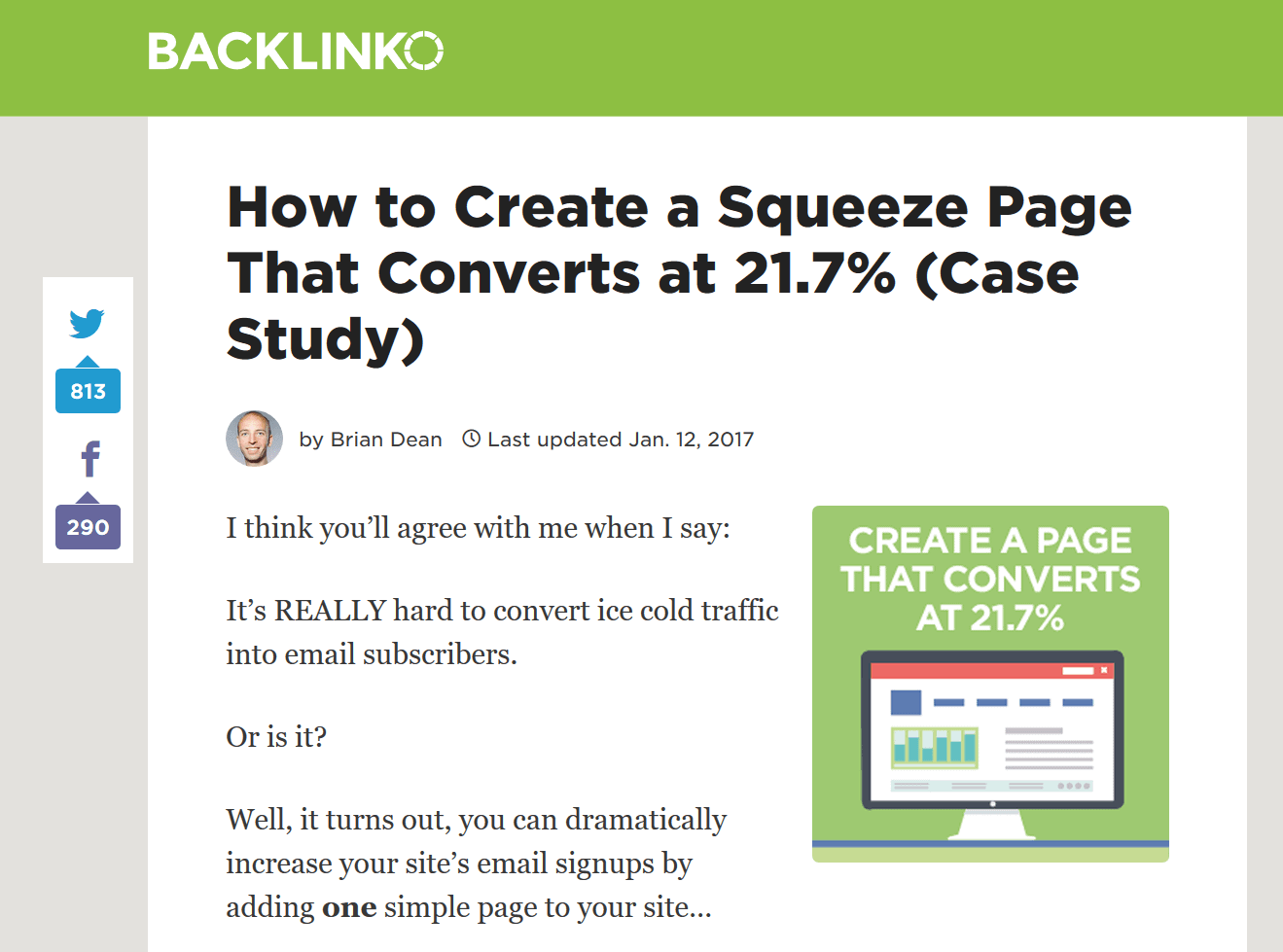
Because I didn’t have a Content Upgrade ready for that post, I decided to let people know that this was the first post in a new series.
I had an announcement at the beginning…

…and end of the post:
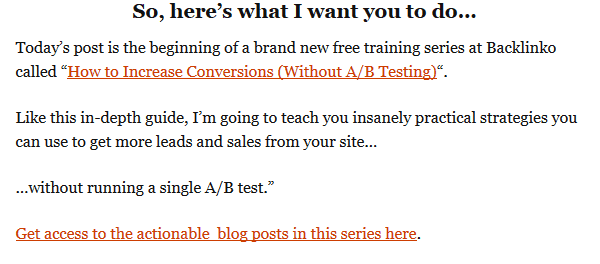
Those are OptinMonster links. When someone clicks on them, an opt-in box appears that highlights the potential loss of not subscribing:

So how has this strategy performed?
Well the two links from that one post very quickly added 37 new subscribers to my list.
Not as amazing as The Content Upgrade, but I’ll take 37 extra subscribers any day of the week.
And if you scale this to some of your most popular blog posts, you’re talking dozens of extra subscribers every month.
Not bad at all for a few minutes of work.
Tweet this List Building technique
15. Use Weird Call to Actions on Buttons
How many times has this happened to you:
You’re about to enter your email address to get your hands on free report…
…and at the very last second, a voice in your head screams out “Don’t do it!”.
So you click away, never to return.
You’re probably wondering:
“How can I prevent that from happening to my potential subscribers?”
Here’s how:
In fact, my first popup used a button that said “Let’s do this!”
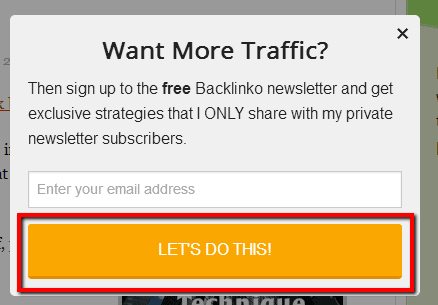
And my homepage button says “Click to Access The Case Study”

Why don’t I use traditional button copy, like “join” or “submit”?
Two reasons:
1) Words like “submit”, “register” and “join” make you feel like you’re committing to something serious.
Not good.
2) Boring terms make your button blend in with the 256,000 other buttons online that use the same 5 words.
On the other hand, whimsical phrases like “Sounds good!” and “Let’s do this!” stand out and put people at ease.
Pat Flynn does a great job of this at Smart Passive Income. The button for his free ebook says: “Get the Guide”

This type of copy sends the message that you’re about to start something exciting…
…not just sign up for yet another email list.
Tweet this List Building technique
16. Turn Blog Comments Into Email Subscribers
Did you know that there’s an easy way to turn blog comments into email subscribers?
Well there is. And it only takes a few minutes to set up.
In fact, it’s is something I’ve recently tested here at Backlinko:
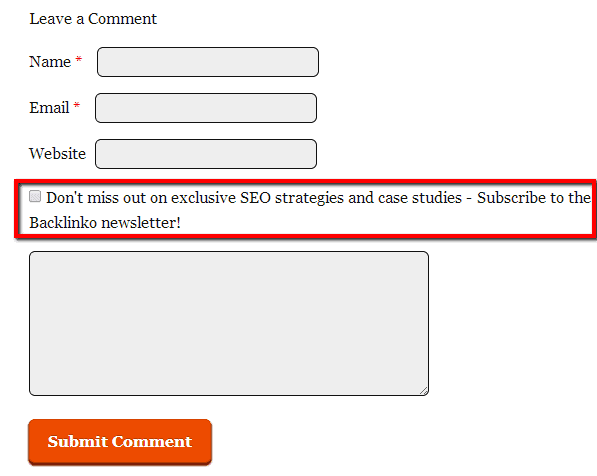
When someone checks that box and leaves a comment, they’re automatically added to my email list.
Although I’ve only had this feature live for a few weeks, it’s already added 214 subscribers to my email list.

Why does this work so well?
When someone leaves a comment on your blog, it usually means that they enjoyed what they just read.
(Or it means they hated what they just read. But haters aren’t going to sign up anyway, are they 🙂 ?)
In other words, commenters are VERY primed to sign up to your list. They just need a little nudge.
If you’re a WordPress ninja, you can set this up manually.
Turning commenters into subscribers works like a charm, but I’ve saved the best technique for last…
Tweet this List Building technique
17. About Page=Squeeze Page
If you’re like most people, you think your about page is a place to tell the world who you are and why you started your blog.
And that’s it.
Well I’ve got news for you:
If you’re not using your about page to ALSO collect emails you’re leaving hundreds (if not thousands) of email subscribers on the table.
After all, your about page is probably one of the most visited pages on your blog (Skeptical? Check your Google Analytics right now).
Like with a blog commenter, someone that takes the time to read your about page is VERY likely to sign up to your list.
That’s why I have not one — but TWO — optin forms on my about page.
One smack dab in the middle of the page:

And another at the bottom of the page (with some social proof thrown in):

These two forms convert EXTREMELY well.
In fact, my About Page converts at 9.31%:
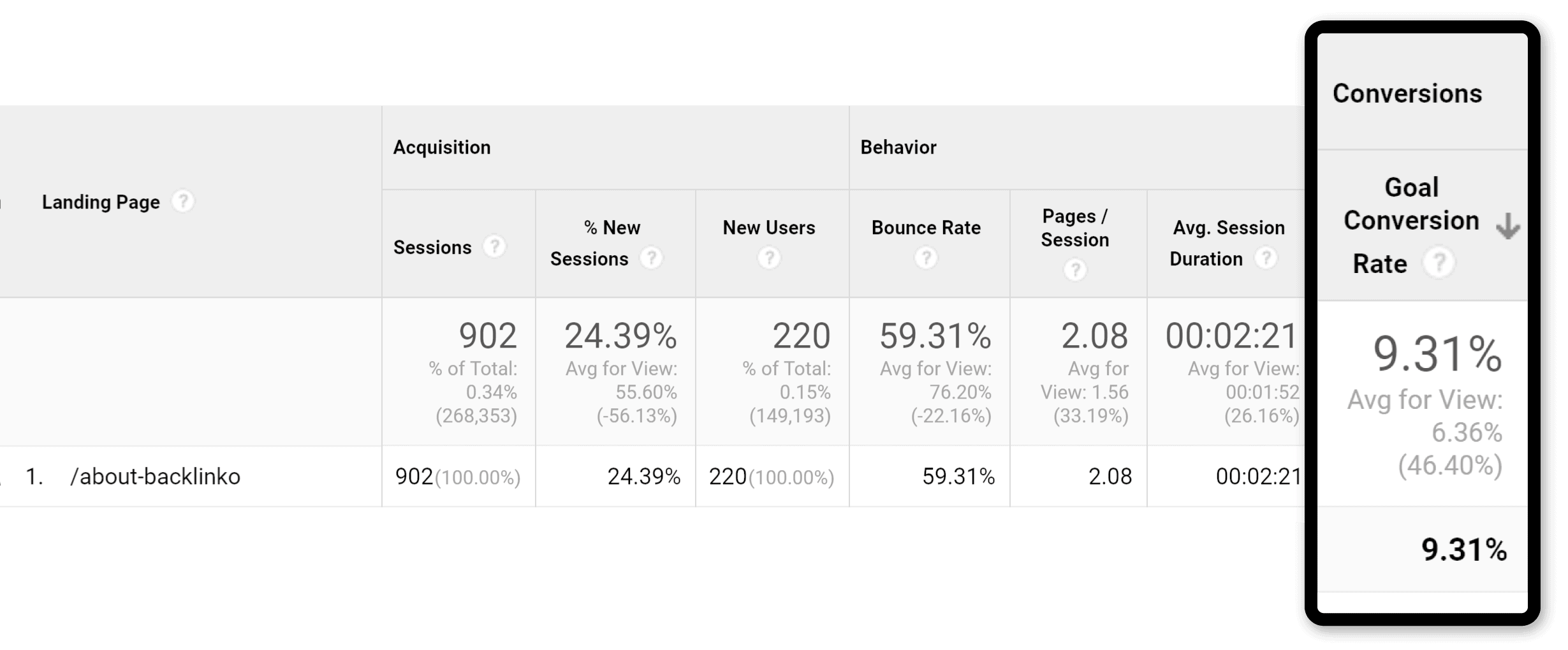
It converts so well that I actually use the Landing Page Funnel Technique (#7 on this list) to funnel more traffic to my About page:
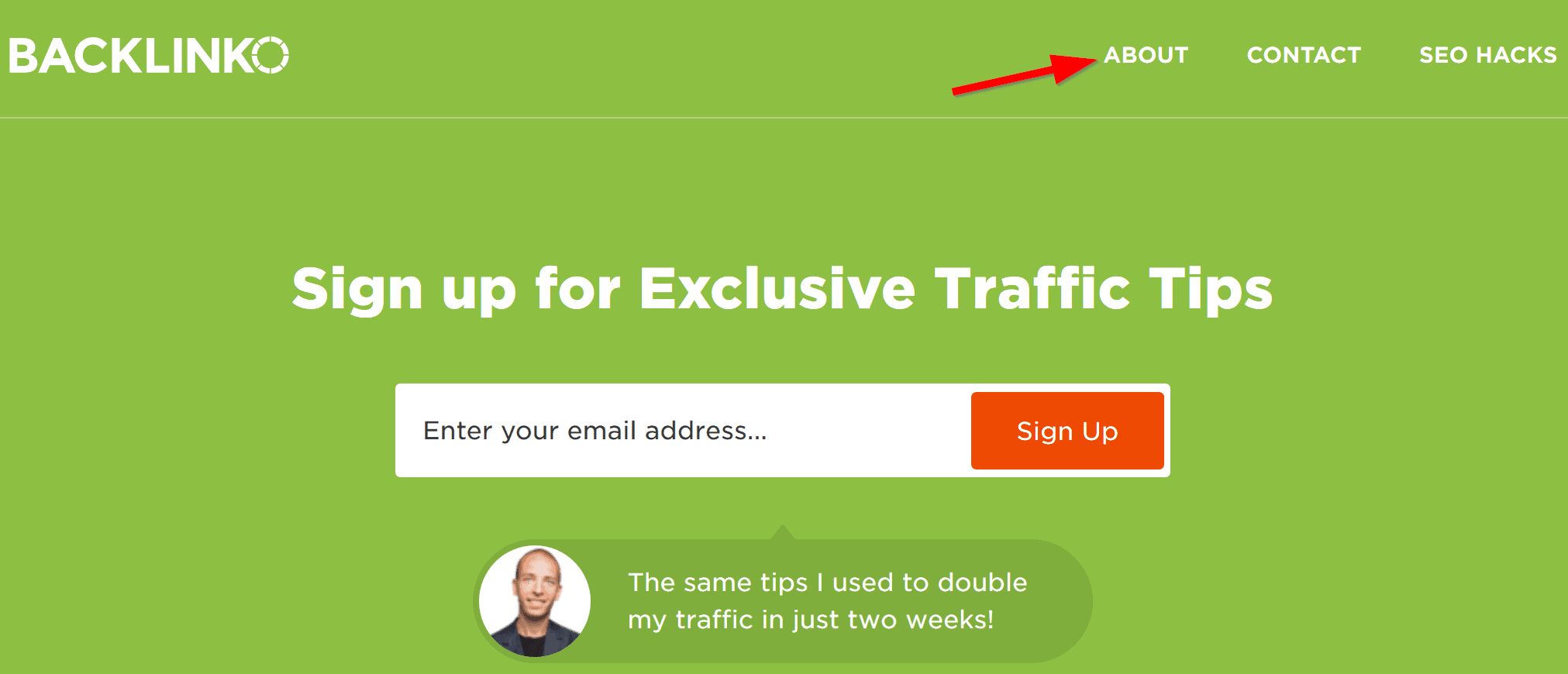
Bottom line?
Sprinkle in at least two opt-in forms in your blog’s about page.